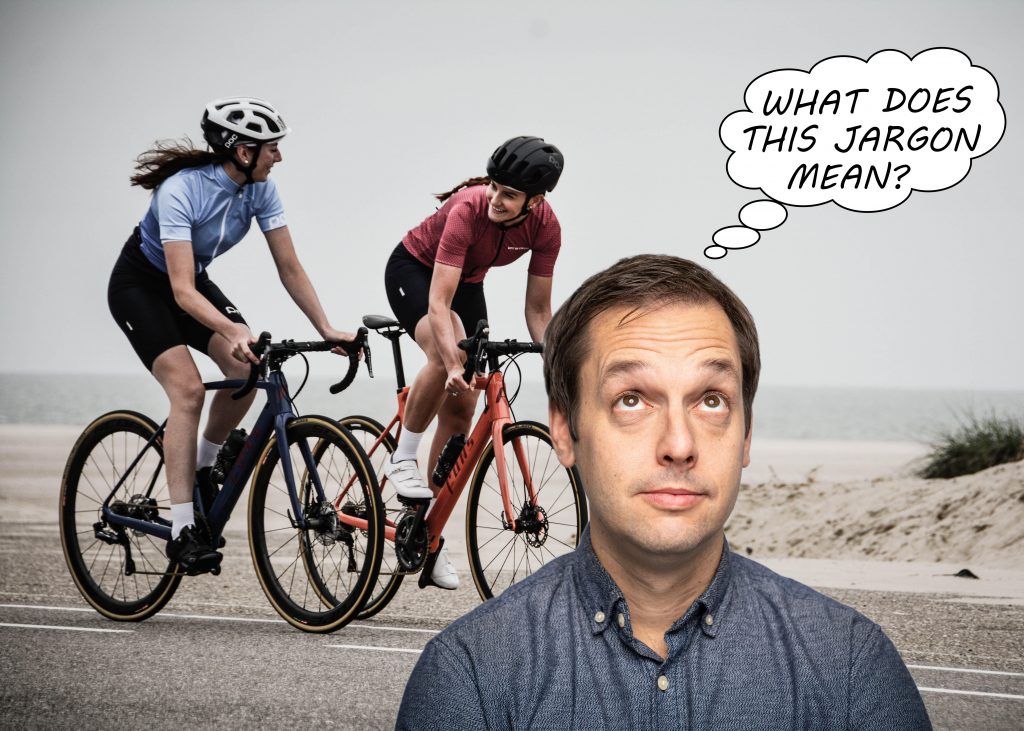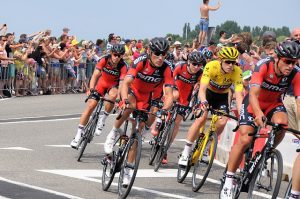Cycling Jargon

Cycling Jargon Explained
Cycling has its own vocabulary and jargon that can seem like a completely different language to an ‘outsider’. However, once you know the lingo, understanding what people (and websites) are talking about become a whole lot easier. So if you don’t know your bottom bracket from your turbo trainer or your bidon from your wheel sucker this list is for you.
Some of them are related to the racing side of cycling, which is deeply entrenched in Europe (Especially France and Belgium). Many have their background in those languages, and for this reason are sometimes literal translations.
If there’s a piece of cycling jargon we’ve missed then let us know and we’ll add it for you.
A
- Abandon – A term used when someone has to quit a ride mid-event “He has abandoned”.
- Aero Bars – Handlebar extensions usually found on Time Trial bikes. These allow the rider to rest on their elbows and consequently adopt a more aerodynamic position.
- Arm Warmers – Lycra sleeves which as they name suggest keep a riders arm warm and are removeable on their own, frequently used on early rides where a long sleeved jersey may be too warm later in the day.
- Attack – To suddenly accelerate when riding in a group in a bid to gain an advantage on the the other riders.
- Autobus – The group of riders in a multi-day stage race who are riding together as a group with the aim of finishing inside the cut off time to allow then to start the following days stage. Usually comprised of non-climbers on a mountain stage or struggling domestiques or those involved crashes on a flatter stage.
B
- Bead – The part of the tyre that grips the wheel rim on a clincher tyre.
- Bidon – French cycling jargon for the plastic water bottle carried on a bicycle.
- Bonk – To run out of energy during a ride leading to a loss of speed or causing the rider to stop completely until they’ve re-fuelled.
- Booties – See Overshoes.
- Bottom Bracket – The bearing assembly that connects the pedal cranks to the bicycle frame.
- Breakaway – A racing term to describe a small group of riders who have attacked off the front of a larger peloton in an attempt to win a race.
- Broom Wagon – A vehicle that follows a race or organised ride with the intention of picking up anyone who can’t complete the event, in essence ‘sweeping’ them up.
- Bunch Sprint – The point usually at the end of a race where a large number of riders arrive near to the finish line at the same time and many of them all compete to be the first across the line.
- Bunny Hop – A manouver usually used to clear an obstacle on a trail or road whereby the rider lifts the front wheel into the air, then the rear wheel, if the timing is right both wheels will momentarily be off the ground at the same time. Also sometimes used as part of a routine in BMX competitions.
C
- Cadence – The rate at which a rider spins the pedals, usually expressed in revolutions per minute.
- Captain – The front, steering, rider on a tandem.

- Casquette – Thin cotton cap frequently worn under a helmet, in the winter it helps to keep the head warm, in the summer it can help to keep sweat out of the eyes.
- Cassette – The cluster of gear sprockets attached to the rear wheel of a bicycle.
- Chain Gang – A group of riders riding closely together, usually drafting, in order to share the wind resistance and optimise training.
- Chain Rings – The one, two or three gear rings attached to the pedal crank arm.
- Chapeau – A classic piece of cycling jargon. An expression of admiration “Chapeau – to you”. Translated from the French for “I take my hat off to you”.
- Cleat – A small metal or plastic plate that bolts onto the underside of a cycling shoe and lets it clip into a compatible clipless pedal.
- Climber – Some who excels in going up hills and mountains in comparison to their rivals.
- Clincher – A type of tyre that uses a bead around its edge to anchor to the rim of the wheel. Can be run with an inner tube or ‘tubeless’
- Clipless Pedal – A rather misleadingly named pedal that has a mechanical system allowing cycling shoes to be clipped on to the pedal.
- Commissaire – A race judge, they may be in a static position on a circuit race or following in a car on a road race. There are typically a number of commissaires in any event.
- Crack (or cracked) – A term used to describe a rider who has run out of energy.
- Cranks – Sometimes referred to as Crank Arms, the (usually) metal arms that the pedals are attached to.
- Criterium – A race comprising of a number of short laps usually with a maximum of around 4-5km per lap. Popular in city centre street racing.
- Cyclocross – A form of multi-lap bike racing on a short course with obstacles and differing surfaces around the lap such as Tarmac, gravel, grass, and mud. Riders will frequently have to dismount and carry their bikes over or around these obstacles and bad surfaces.
D
- Derailleur – The mechanical device that moves the chain from one cog to another. Depending on the number of gears bikes my have one or two. A rear one that changes the chain onto a different cog on the cassette. And a front one that changes the chain to a different chainring on the crank.
- Director sportive – Literally translated from French to mean ‘Sport Director’. Essentially the manager for team cycling events. In larger events they are likely to be in a car following the race.
- Domestique – In professional racing circles, a team usually has one (or occasionally two) designated team leaders who will be expected to compete for overall victory. The Domestiques are those riders that are there to support the leader(s). The provide assistance by dropping to the team car for food and supplies, providing cover in windy conditions (drafting), and will even be expected to give up their bike if the leader has a mechanical problem.
- Drafting – The art of riding behind other riders to gain an aerodynamic advantage by riding in their slipstream which uses less energy.
- DNF – An acronym for Did Not Finish, in results to indicate a rider in a race who did not complete the course.
- DNS – An acronym for Did Not Start, on results to indicate a rider who entered but did not start the race.
- Domestique – French cycling jargon describing a rider who is part of a team but not the designated team leader. The riders are generally there to support the designated team leader and provide assistance during a race.
- Drafting – The act of riding behind another rider in their slipstream in order to gain an aerodynamic advantage.
- Dropped – Term used to describe someone who has been left behind in a group ride / race.
- Drops – The lower curved part of the handlebars on a road bike.
E
- Echelon – A diagonal line of riders positioned in such a way as to gain aerodynamic advantage in a cross wind.
- Etape – Another French racing term. In a multi-day stage race, each daily stage is known as an Etape.
F
- Feed Zone – A section of a course in a bicycle race where riders can accept food and drink from non-racing assistants.
- Fixed Wheel – Sometimes referred to as ‘Fixed Gear’. A gearing system with one chainring at the front, one cog on the back and no freehub so riders can’t freewheel. An arrangement that’s common on track bikes and also very popular with bicycle couriers as there is less maintenance required.
- Flame Rouge – Translates from French as ‘Red flame’ this is usually a red triangular flag displayed showing racers they are about to enter the last kilometre of the race.
- Fork – The part of the bicycle that attaches to the front wheel and connects to the handlebars.
- Frameset – The complete bicycle frame including the front fork.
- Front Mech – The Front Derailleur, used to change gear using the chainrings.
G
- Grand Tour – A very long multi-day stage race. There are three Grand tours, The Tour de France, Vuelta a Espania, and Giro d’Italia. These are all in Europe and are the most prestigious races of the calendar each year.
- Gravel Bike – A bike that looks like a road bike but is built for gentle off-road use. Tyres are usually wider than road at around 40mm. Generally these bike also have disc brakes and flared drop handlebars.
- Gruppetto – An Italian version of the term Autobus
H
- Half-Wheel – To ride with the front half your front wheel overlapping the rear wheel of the rider in front. Considered a bad practice on a group ride as any sideways movement by either rider will cause an accident.
- Hooks – See Drops.
- Hybrid – A bike that is a cross between a road bike and a mountain bike. Usually has straight handlebars and road style geometry. Tyres are usually wider than normal road tyres but not as wide as MTB tyres. See also Gravel Bike.
I
- Individual Time Trial – A sporting event where riders start at set intervals and then race against the clock to complete the course. The rider with the quickest time wins.
- Intermediate Sprint – A competition within a longer stage race where riders compete to be the first past checkpoints along the course usually to win time bonuses or points for the larger race.
J
- Jersey – Tight fitting lycra cycling top, usually in bright, possibly team colours and zippered at the front with one or more rear pockets for carrying supplies and spares etc.
K
- Keirin – A 2000 metre track race where the riders ride behind a small motorbike for around 1400 metres after which the riders sprint race the last 600 metres. Very popular in Japan.
- Kick – To accelerate quickly away from other riders in a race in order to gain an advantage.
- KOM – King Of the Mountains, an award usually given to the best climber in a multi stage race. More recently commandeered by cycling app ‘Strava’ to denote the fastest person on a given geographic segment.
L
- Lantern Rouge – French for ‘Red Lantern’, a term of endearment given to the last man in a race, believed to have originated from the red light shown at the rear of a train.
- Lead Out – A racing manoeuvre whereby one rider allows a teammate to draft at high speed giving them a head start for their own attack.
- Line Out – When a group of riders ride in a single file line instead of a bunch.
- Lowracer – A racing version of a lowrider, often utilising an aerodynamic fairing.
- Lowrider – A short wheel based recumbent bicycle, usually very low to the ground to reduce the amount of wind resistance.
- Lycra – Developed by DuPont Lycra is a fabric widely used in sport. It’s stretchable, breathable and comfortable making it an ideal fabric for cycling.
M
- Maglia Rosa – Italian for Pink Jersey, worn by the leader in the Giro D’Italia stage race.

- Maillot Jaune – French for Yellow Jersey, worn by the leader in the Tour de France stage race.
- MAMIL – Another piece od derogatory cycling jaron. Acronym for Middle Aged Man In Lycra. A semi-derogatory term used to describe men whose body shape doesn’t necessarily conform to the stereotypical ‘Racing Snake’.
- (A) Mechanical – A problem associated with the moving parts of a bicycle such as the gears, brakes, etc.
- MTB – Abbreviation for Mountain Bike.
- Musette – The (usually) cloth bag handed out to riders part way through a long day race / stage at a designated feed zone which will contain additional food for the ride.
O
- Off the back – Someone who has been dropped by a group / peloton, eg – “He’s off the back”.
- On the Hoods – To ride with your hands around the rubber hoods of the brake lever on a drop bar bicycle as opposed to being on the drops or on the top of the handlebars.
- On the rivet – A rider who is riding at maximum effort is described as being ‘on the rivet’.
- On the wheel – A term used describe someone who is riding very close to the rear wheel of another rider in order to gain an advantage (usually aerodynamic).
- Overshoes – A fabric, neoprene or sometimes rubbery boot-like garment used to keep the feet warm in cold and / or wet conditions.
P
- Paceline – A group of riders riding at (usually) high speed that, as a result, are employing drafting to gain an advantage. Consequently, riders will take turns at the front to break the wind.
- Pannier (bag) – A bag that is usually attached to the rear frame of the bike enabling more luggage to be carried. Some bicycles can also have panniers attached to the front fork.
- Pave – French term used to describe a cobblestone road.
- Peloton – The main bunch of riders travelling together in a race. They may not necessarily be leading the race as there may be a small ‘Breakaway’ further ahead of the Peloton.
- Poursuivant(s) – A rider or group of riders between a breakaway group and the peloton.
- Presta Valve – A high pressure inner tube or tyre valve most commonly used on road bikes and sometimes hybrid bikes.
- Prologue – A short individual time trial on day 1 of a large multi-day stage race. Usually used to determine who will wear the leaders jersey on the first proper stage.
Q
- QOM – Queen of the mountains. See KOM.
- Quick Release – A skewer / bolt / cam lever system that allows a wheel to be removed and re-fitted quickly and easily without the need for tools.
R
- Racing Snake – A rider who conforms to the stereotypical racer body shape with a lean frame and very little body fat.
- Randonnee – A long, usually multi-day recreational riding event.

- Rear Mech – See Derailleur.
- Recumbent – An alternative shape of bicycle where the rider sits as they would in a chair with their legs in front of them.
- Road Captain – A (usually) experienced rider who organises the team in a road race. Duties include making tactical decisions in conjunction with the teams director sportive.
- Roaddie – A nickname for a dedicated road cyclist.
- Road Race – A long from race usually raced on public roads and paved surfaces.
- Road Rash – Grazes / abrasions on a riders body, arms, or legs caused by crashing and sliding on tarmac.
S
- Schrader Valve – Inner tube or tyre valve commonly used on mountain bikes and other bikes with wider tyres. This is the same valve as found on car tyres.
- Shifter – Cycling jargon shortened from Gear Shifter. The lever that changes gears – can some in a number of guises depending on the type of bike.
- Smart Trainer – See Turbo Trainer. It can simulate gradients and flats with no intervention by the rider because it can be automatically controlled by an electronic device. Popular with users of the Zwift service.
- Soigneur – A member of a teams backroom staff who’s job it is to look after the riders, their tasks frequently include food preparation, and massages.
- SPD’s – A type of clipless pedal system. Developed by the Shimano company, it has two types, one for road shoes and one for off road shoes. Commonly referred to as ‘spuds’.
- Spin – As in ‘Spin the pedals’. To pedal in a smooth rhythmic motion.
- Sprinter – A type of racer who can generate high speed and power in short bursts, usually to finish a race or win an intermediate sprint.
- Stage – In a multi-day race each day is known as a stage. Each stage is essentially a race within a race with it’s own winner.
- Summit Finish – A race finish that is typically at the top of a mountain or very steep climb.
T
- Tete de la Course – French for race leader. Frequently used in the Tour de France, translates literally as ‘Head of the course’.
- Time Trial – A competition where individuals or sometimes teams race one at a time against the clock over a measured course. The winner is the person (or team) that completes the course in the shortest time.
- Track – An oval banked cycle course for competing in sprint type racing. Also see Velodrome.
- Tubeless – A wheel / tyre system that eliminates the need for an inner tube. To this end, tyres will be filled with liquid sealant that prevents the escape of air, and can often seal up small punctures.
- Turbo Trainer – A device that allows a rider to ride in a stationary position by raising the rear wheel from the floor and sitting it on a roller. Turbo trainers are usually able to vary the amount of resistance applied to the roller. This in turn allows them to simulate riding varying gradients.
U
- UCI – Founded in France in 1900 the Swiss based Union Cycliste Internationale is the international governing body of bicycle racing.
V
- Velo – An abbreviation of the early French word for bicycle (Velocipede). Many cycling clubs and cycling-oriented businesses incorporate the word Velo in their name.
- Velodrome – An indoor or outdoor oval racing track usually with banked curves to promote faster racing. As a rule, most tracks are usually 250 metres in length.
W
- Watt – A measurement of the amount of power that a rider can produce. It is effectively the amount of force applied to the pedals.
- Wheelie – A bicycle trick that involves lifting the front wheel. The rider then moves balancing only on the back wheel.
- Wheel Sucker – a derogatory piece of cycling jargon. Someone who sticks to another riders rear wheel and therefore doesn’t take a turn at the front.
X
Y
- Yellow Jersey – The leader of the Tour de France wears a yellow jersey. Because of this he is often referred to as ‘The Yellow Jersey’. The Jersey is yellow because L’equipe newspaper which had yellow pages sponsored early stagings of the Tour
Z
- Zwift – An online service that links to compatible ‘smart’ turbo trainers. It creates virtual worlds in which riders can race / train without having to leave the comfort of their home.
If you have a piece of cycling jargon you don’t see listed why not drop of a message using the contacts page or Facebook page and we’ll add it.








